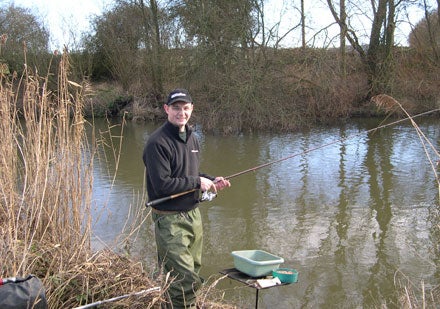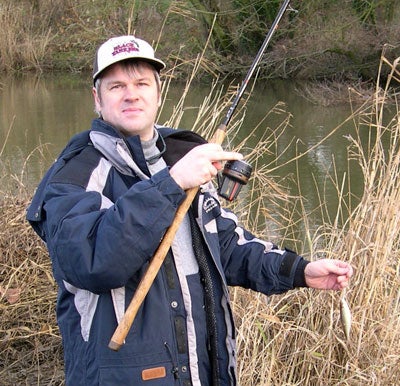| MARK WINTLE |
| Mark Wintle, an angler for thirty-five years, is on a quest to discover and bring to you the magic of fishing. Previously heavily involved with match fishing he now fishes for the sheer fun of it. With an open and enquiring mind, each week Mark will bring to you articles on fishing different rivers, different methods and what makes rivers, and occasionally stillwaters, tick. Add to this a mixed bag of articles on catching big fish, tackle design, angling politics and a few surprises. Are you stuck in a rut fishing the same swim every week? Do you dare to try something different and see a whole new world of angling open up? Yes? Then read Mark Wintle’s regular weekly column. |
| IT LOOKS EASY BUT… By Mark Wintle and Neil Laing Mark Wintle:
With a long Christmas break looming, it was question of pencilling in a day and hoping that the river gods were smiling… We chose the Tuesday after Christmas, and as I described in my article on water colour, it was the morning after the deluge. Neil drove across from Bournemouth to meet me, and from there, we went to look at the Stour at nearby Wimborne. The intention was to fish on the Upper Stour above Blandford where there are many stretches of steady flowing river, and plenty of small fish. At Wimborne the river didn’t look too bad, so we drove up the valley and peered over the bridge on Blandford bypass. The first ominous signs that all was not well appeared. In the edge, the river was reasonably clear but down the centre of the river, it was colouring up badly with lots of floating debris. Before diverting to a stillwater, we went to check at one of the bridges five miles upstream. Here it was already three feet up, very coloured and rising fast. Though we could have scratched about fishing one of the slacks, the chance of learning much on a river would have to wait for much better conditions. We went to the lake mentioned in my article where I showed Neil the technique of fishing thirteen feet deep under overhanging trees with a fixed waggler for bream. A Week Later A week later and the river had dropped and it looked far more promising. I could only spare about four hours in the morning so we made an early start for the upper Stour. This time the river was in good condition and after a half-mile walk we got onto the riverbank. In the course of previous discussions I had discovered that Neil wasn’t really kitted out for river fishing; the float rod that he owned was cheap and cheerful, his reels were loaded with heavy line, and his landing net was an unsuitable carp net. It became clear that the easiest thing to do until he decided whether to continue trying to master what is quite a challenging method would be for me to lend him a rod, reel and net. I dug out a Daiwa match rod, closed face reel loaded with 2lb line and a landing net. Neil had some suitable stick floats, and after selecting what I thought should be a couple of promising swims, with an upstream wind and good depth, I helped him tackle up a big stick float (5BB). Though shirt-button style would have been ideal, it is easier for a beginner to fish with a bulk plus droppers. Neil had tied a size 20 to nylon so that was the hook taken care of. Before I went to supervise Neil, I wanted to check that there was some life in my own swim. If you are trying to help someone else catch fish, it’s as well to know that there are some fish willing to bite. My set-up was slightly different in that I wanted to try to catch on bread punch on a 16 and, though my shotting pattern was similar with a bulk and droppers, I was using a crowquill Avon taking about 6 BB. I was also groundbaiting. After plumbing up to find around nine feet of water I started fishing, feeding a ball of groundbait about a third of the way across the twenty yard wide river. What did immediately become apparent was that the low angle of the sun, tree reflections and the ripple from the strong breeze made it hard to see the float for much of the swim. After one swim down without a bite I deepened up by three inches, added another no. 8 shot and tried again. This time a slight dip of the float registered a bite and I had my first roach. A slightly better one followed the next cast, though it was only about four ounces. It was time to get Neil underway. Cast, feed, trot and retrieve The important thing when teaching someone how to fish is to demonstrate what you are trying to achieve. It was a case of cast, feed, trot and retrieve. It took a few casts to find out the contours of the swim; no snags as such but that sun in the ripple was also troublesome. I did get one little roach so there were fish about. Neil had a go. At present, his biggest challenge seems to be smooth and effortless casting. When you’re used to fishing stillwaters with heavy gear it’s easy to get used to just using overhead casting but close in floatfishing is better with underhand casting where the line is grasped in the left hand so that the rod is used like a spring to get the cast under way. With the favourable wind, the actual trotting was straightforward. One of the hardest lessons for many anglers is learning to feed every cast but Neil quickly picked this up. But the major problem of the glare was getting worse, and with limited time and no fish as yet, I went on a quick recce upstream to see if I could find two swims where the effect of the sun was reduced. Fortunately, just a couple of hundred yards upstream there were two such swims. I fished one of them. It was very deep at over thirteen feet but an interesting challenge. It took time to suss out. The punch on a 16 was too crude; I switched to maggot on a 20 but only got a small perch before switching back to the 16 with a smaller punch. With time running out I didn’t bother changing to a finer wire 18 to a finer hooklength though feel sure this would have been the answer. Neil, meanwhile, was getting into his stride at last with a steady succession of small roach, perch, dace and gudgeon. Mark’s Conclusions Neil has made a promising start to trotting on a river. He’s enjoying it, which is the main thing, and catching a few fish. There’s a lot to learn yet with perseverance he can only improve. Neil’s Story – Admit you need help! I started fishing again in December 2002, however my previous experience was only a fleeting interest as a youngster back in the mid- 70’s. It was almost starting from scratch and as I usually fish on my own I have been learning through trial and error, reading magazines and looking at the excellent FM site.
When Mark agreed to me joining him on the river I couldn’t believe my luck in getting this opportunity, although I was a bit apprehensive at exposing my limited ability against his skills honed through years of practise and match fishing. As our first attempt to get on the river was scuppered by the weather, I also had the added bonus of some lessons in stillwater fishing. I think the carp anglers on the first lake were there just to escape the Christmas festivities for a while, and didn’t really expect to catch in the poor conditions. Our move to a different stillwater was made easy as we had minimum gear with us, only one rod each and no seats to carry. Mark defied the odds at the second lake with his ultra-fine tackle and lightning reactions to the most diminutive of dips on a float, which was dotted down so it just broke the surface. The results- six bream to 2.5lb, small roach and a perch. I am sure I wouldn’t have even seen the bites if I had been on my own. Lesson Two It was just into the start of 2005, and Mark was much happier at the prospect of fishing the river now conditions had improved markedly. Again, the tackle recommended appeared to me to be very fine: 5BB float and 1.4lb pre-tied to a carbon match size 20 spade-ended hook. Mark explained we could get away with a lighter float as the river was flowing steadily. The upstream wind made trotting easy and I didn’t need to mend the line, as it appeared to stay behind the float on its own. I did, however, have difficulty seeing the float against the sun and high ripple on the water. Mark said, “I don’t want you blanking – we had better find more sheltered swims.” I watched Mark settle down in his second swim. He set the depth carefully and then proceeded in the routine of stabbing a slice of bread with his home-made bread punch, wrapping his arm around the rod to free both hands to bait the hook (who needs rod rests?) and flicking the float out. Then he squeezed a small handful of groundbait (continental groundbait mixed 50/50 with brown crumb) and threw it out about four yards upstream from where the float had landed. He explained that if the groundbait made a plop sound as it hit the water then it was mixed right to get it down to break up on the bottom. Having banked a few roach of a better stamp than we had caught on the lakes it was time for me to have another go in the next swim upstream. On arriving, Mark pointed out a flock of fieldfares high in the treetops, commenting they were normally found much further North. I found this swim a lot easier and eventually managed to catch some roach, perch, dace and a gudgeon, usually at the end of the trot. Apparently, it takes a while for the float to settle and the bait to get to the bottom. Before meeting with Mark I had already concluded that sitting behind a pair of carp rods all winter, waiting in vain for an alarm to go off, wasn’t for me. The next obvious thing is to try moving water where the fish are more likely to feed from time to time due to expended energy. It was noticeable that fish were to be found on sections of the river where trees are close by, as the cormorants like more open areas. Why not give trotting on the river a try? It is challenging but if I can get some fish most anglers should get some action. My thanks to Mark for his guidance, loan of equipment and putting up with my incessant questions! The techniques I will need to practise, but I think this has moved my fishing forward no end – it needed the help! |















